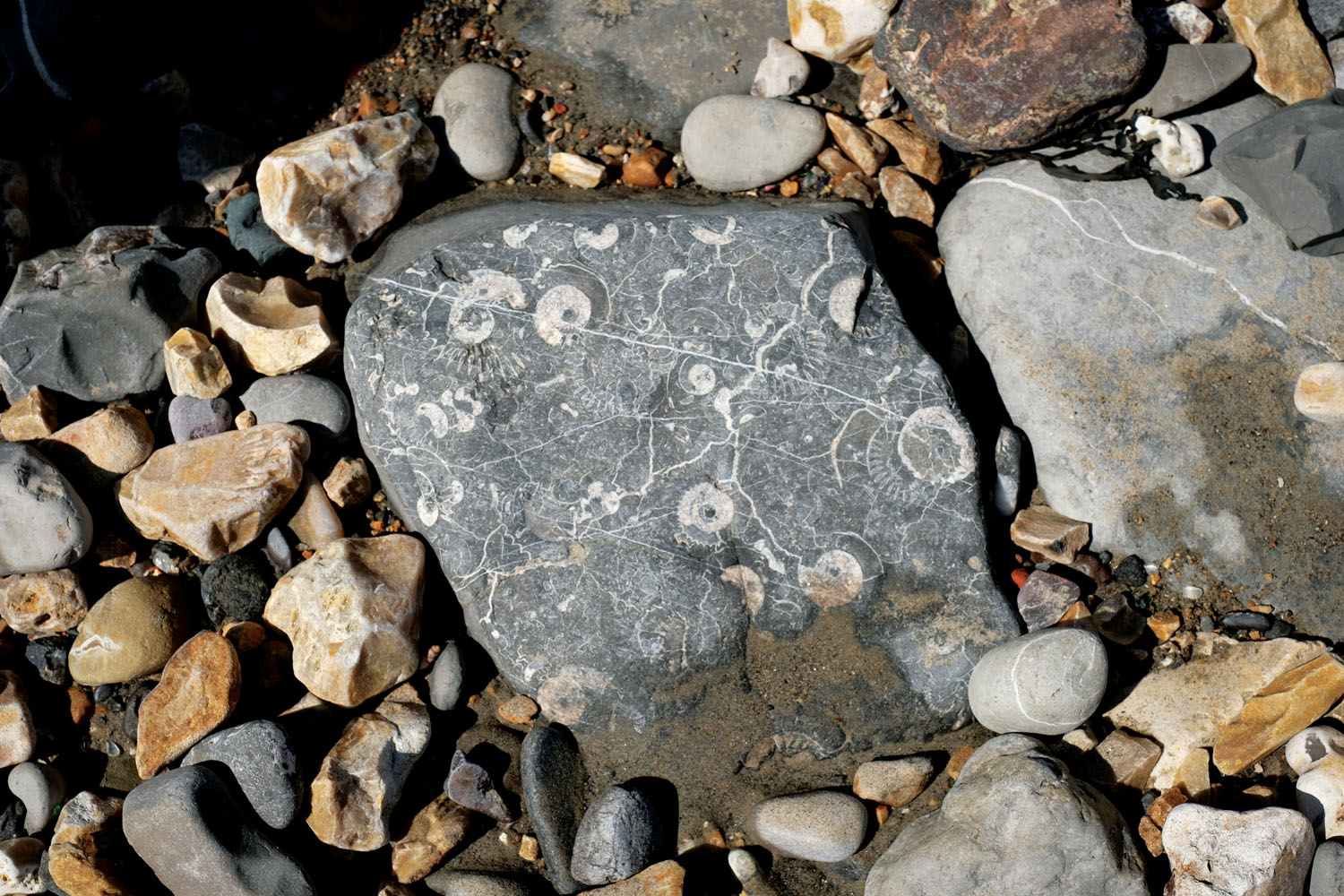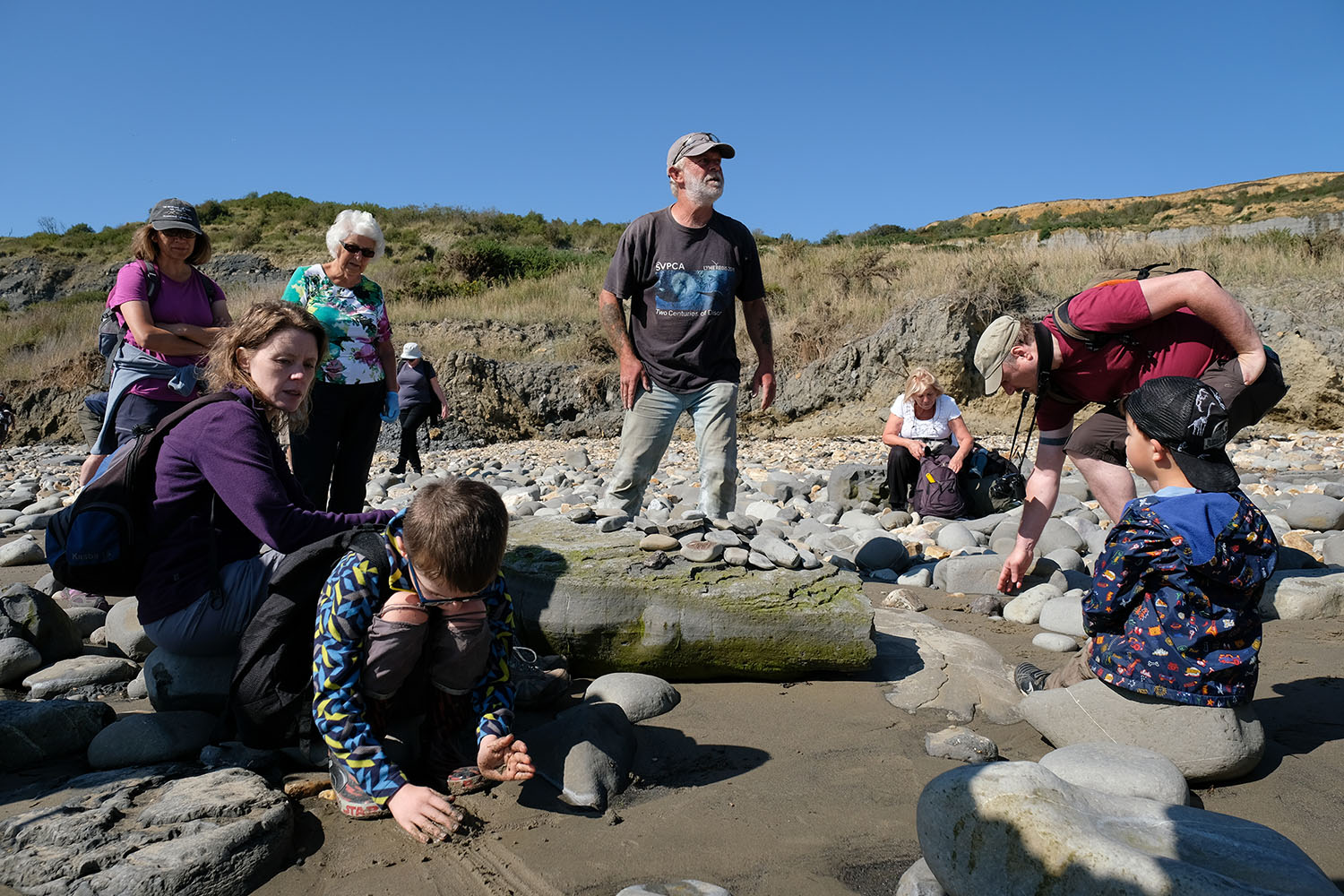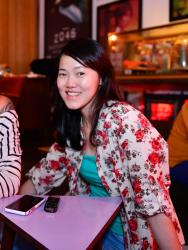1.

“You’ve come in the worst conditions,” Paddy Howe says drolly. It’s September and the seaside town of Lyme Regis is still basking in summer. Sunlight scintillates off the water, the sand-and-shingle beaches, the white façades of Georgian shophouses, hiding the fossils in plain sight of everyone who has come to pick them.
Howe, a local museum geologist, leads a motley crew of adults and kids along a stretch of beach between Lyme Regis and Charmouth, which forms part of the Jurassic Coast: Ninety-five miles of shoreline backed by craggy cliffs streaked in shades of green, blue gray, and brown, named for the fossils they still hold from the Mesozoic—the “Age of reptiles”—250 to 65 million years ago. It’s a landscape that has its own peculiarly evocative vocabulary: Church Cliffs, layered with limestone and shale called Blue Lias, and the ominous-sounding tumbled mass of Black Ven, with strata of Marl, Shales-with-Beef, and Greensand. It’s one of Britain’s largest active landslips, and after heavy rains, it can move as much as ten meters in a night: “A conveyor belt of fossils,” Howe calls it.
The volatility of this land makes some of the homes here unmortgageable, but it’s also what coaxes its secrets out. Howe tells us that rain turns the clay, shale, and rocks into mud, which flows down the slope and brings the fossils with it. Then the waves wash the mud away and leave the fossils on the beach. They’re easier to see when they’re wet and shiny. “That’s why I’ll go out during a storm, if it’s not dangerous to do so. If I wait, someone else will get there first.” He’s been “hooked on looking” since he was six years old.
It’s on this stretch of beach in 1812 that Mary Anning, a young girl and pioneering local fossil hunter—who would likely be better-known today had she been born a man—unearthed the remains of a whole ichthyosaur. It was like no other creature the world had ever imagined, with eyes that seemed to bulge, a body like a dolphin’s, and a mouth like a crocodile’s. Almost two hundred years later, on this same stretch of beach, Howe found his ichthyosaur. It now hangs in the local museum.
“That’s not an everyday find, and I can’t promise you one of those today. But it’s well within the range of possibilities.”
2.

History tells us that she was struck by lightning as a baby, and was never the same again; that she inspired the tongue twister “she sells seashells by the seashore”; that, though she came from a poor family and was uneducated, she held her own among male scientists of the day, and once declared to a royal entourage: “I am well-known throughout the whole of Europe.” They say she never married, and speculate about the affairs she might have had. “There’s so much we don’t know about Mary,” says Paddy Howe.
What’s undeniable, however, is the contribution she made to the nascent field of paleontology in the early nineteenth century. It’s said that it was actually her brother Joseph who first stumbled on the skull of Mary’s seventeen-foot-long ichthyosaur—the first in the world to be documented—but that she found the rest of it. And it was she who dedicated her life to fossil hunting as a means of supporting her family after her father, who had always taken Mary and Joseph with him to hunt for fossils, died in 1810. At a time when the salubrious effect of the sea was popularly touted, and the Napoleonic Wars discouraged travel abroad, Lyme Regis developed into a seaside resort, and tourists came wanting to take something home—a piece of vertebra, a rib—to add to their cabinets of curiosities.
After her ichthyosaur, Mary Anning would go on to discover the first complete skeleton of the long-necked plesiosaurus in 1823 and the pterodactyl, then believed to be the largest flying animal, in 1828—all now exhibited at London’s Natural History Museum. With hindsight, it’s hard to imagine how shocking her finds must have been at the time, when religious explanations of the world were being questioned and the theory of extinction was being introduced, eventually culminating in Darwin’s theory of evolution by natural selection.
“Mary’s ichthyosaur was a controversial thing,” says Natalie Manifold, who leads Mary Anning–themed tours. “It brought into question the perfection of God’s creation. Because this creature had died out, it made you wonder, was it really such a perfect creation?”
It’s not clear how Mary Anning reconciled her family’s Protestant convictions with her discoveries. But her sea monsters forever changed how we thought about our world and our origins in it.
3.

Amid sunbathers reading seaside, the amateur fossil hunters scuttle along the beach, rummaging through loose shingle, tinkering in mud beds with their hammers. They look as curious as the curiosities they’ve come to find. Maybe it’ll be the vertebrae of an ichthyosaur. Maybe an ammonite, with only its spiral shells left; or a belemnite (once known as Devil’s Fingers), with pointy bullet-shaped remains—related to both what we know as squid and cuttlefish. Or maybe a Devil’s Toenail: a genus of extinct oyster. Or fossilized poo called coprolite. “You may have heard the expression, ‘You can’t polish a turd,’” Paddy Howe says, his grizzly white face twitching. “Yes, you can,” he deadpans.
The names sound like keys to a kind of time machine, back to an age when this was all seabed and these creatures swam in shallow tropical waters, while dinosaurs roamed on nearby land. That’s how dinosaur remains have been found here too, like the Scelidosaurus. “They were almost certainly drowning, washed by rivers flooding into the ocean,” Howe says.
The population of Lyme Regis swells from 3,500 to 25,000 in the summer. The tourists mill in and out of the chippies and tea rooms and fossil shops, still doing what tourists did back in Mary Anning’s day. On Broad Street, perched on higher ground overlooking the sea, there’s a shop bearing the sign anning’s fossils—part of the set created for an upcoming film starring Kate Winslet and Saoirse Ronan. “Mary Anning is very much in the air at the moment,” Howe says. She’s in the school curriculum and many kids come to Lyme Regis on field trips. It’s a welcome turn considering that until her death at age forty-seven from breast cancer, at a time when women were banned from joining scientific societies or authoring academic papers, she received no formal credit for her discoveries or her studies of them.
One night, at the St. Michael’s Churchyard, Natalie Manifold points out the single tombstone engraved with the names of Mary, her brother Joseph, and his three children. “We don’t really know if this is where the Anning family is actually buried,” she says. “Because of the erosion of the cliffs, the headstone has been moved around. So it’s entirely possible that Mary Anning is actually in the sea, or maybe she’s next door.”
I pick at the fossils circling the grave. And it feels apt, somehow, to think of Mary Anning like this: scattered among the sea monsters she had looked for all her life.
These dispatches are from #VQRTrueStory, our social-media experiment in nonfiction, which you can follow by visiting us on Instagram: @vqreview.







